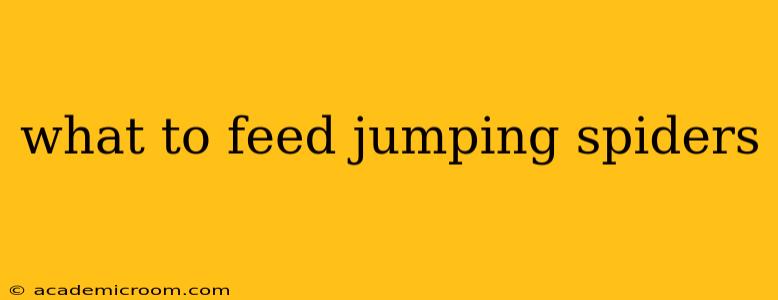Jumping spiders, with their captivating personalities and incredible hunting skills, make fascinating pets. However, providing them with the right diet is crucial for their health and longevity. This comprehensive guide will answer all your questions about feeding these amazing creatures, ensuring your jumping spider thrives under your care.
What do jumping spiders eat in the wild?
In their natural habitats, jumping spiders are voracious predators, primarily consuming insects. Their diet consists mainly of:
- Flies: These are a staple food source, readily available and easily caught by jumping spiders.
- Small Crickets: Depending on the size of your spider, appropriately sized crickets can be a good addition.
- Grasshoppers: Similar to crickets, these should be offered in sizes suitable for the spider.
- Other Small Insects: This could include things like aphids, mealworms (occasionally, as a supplement), and fruit flies (especially for spiderlings).
What should I feed my pet jumping spider?
Captive jumping spiders need a similar diet to their wild counterparts. The key is offering appropriately sized prey. Too large a prey item might injure or overwhelm your spider; too small and it might not be a worthwhile meal.
A good rule of thumb is to offer prey items no larger than the spider's abdomen. Fruit flies, especially Drosophila melanogaster, are excellent for spiderlings and smaller adult spiders. Larger spiders can handle larger prey like house flies or small crickets.
Important Considerations:
- Frequency: Feed your spider every 1-3 days, depending on its size and appetite. A well-fed spider will often refuse food.
- Variety: While a consistent diet is important, offering some variety in prey types can ensure your spider receives a balanced diet.
- Live Food Only: Jumping spiders are ambush predators and require live prey to trigger their hunting instincts. Dead insects are generally not accepted.
- Gut Loading: To maximize nutritional value, feed the insects you intend to give your spider a nutritious diet before offering them to your spider. This ensures your spider benefits from more vitamins and minerals.
What are some good foods for baby jumping spiders?
Spiderlings require smaller prey items. Fruit flies ( Drosophila melanogaster) are ideal because of their size and ease of breeding. Very small crickets (pinhead crickets) might also be suitable, but ensure they are appropriately sized.
Can I feed my jumping spider mealworms?
Mealworms can be offered occasionally as a supplement to a varied diet, but they shouldn't be a staple food source. They are relatively high in fat and lack some essential nutrients compared to other insects. It's always best to prioritize flies and other insects naturally found in a spider's environment.
What should I avoid feeding my jumping spider?
Avoid feeding your jumping spider anything that is toxic or could pose a threat, such as:
- Insects treated with pesticides: These can be harmful and even deadly to your spider.
- Wild-caught insects: These might carry parasites or diseases.
- Large prey items: These can injure or overwhelm your spider.
How do I know if my jumping spider is getting enough to eat?
A healthy, well-fed jumping spider will be active, alert, and have a plump abdomen. If your spider seems lethargic or its abdomen appears shrunken, it might need more food. However, remember not to overfeed.
By following these guidelines, you can ensure your jumping spider receives a nutritious and balanced diet, leading to a long and happy life. Remember to observe your spider's behavior and adjust its feeding schedule as needed. Remember to always prioritize the health and well-being of your pet.
